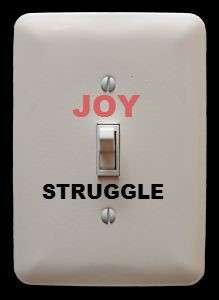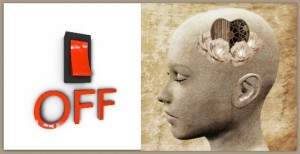
Eliminate Suffering with a Flick of a Switch!
 Have you ever seen one of those old movies where the bad guy falls into a pool of quicksand, and the more he struggles, the faster it sucks him under? If you should ever fall into quicksand, struggling is the worst thing you can possibly do. What you’re supposed to do is lie back, spread your arms, and lie as still as possible, floating on the surface (then whistle for your horse to come and rescue you!) Acting effectively in this situation is tricky, because every instinct tells you to try to escape; but if you don’t stop struggling, pretty soon you’ll sink beneath the surface. Ok, so it’s not exactly fun to be floating on quicksand, but it sure beats drowning in it!
Have you ever seen one of those old movies where the bad guy falls into a pool of quicksand, and the more he struggles, the faster it sucks him under? If you should ever fall into quicksand, struggling is the worst thing you can possibly do. What you’re supposed to do is lie back, spread your arms, and lie as still as possible, floating on the surface (then whistle for your horse to come and rescue you!) Acting effectively in this situation is tricky, because every instinct tells you to try to escape; but if you don’t stop struggling, pretty soon you’ll sink beneath the surface. Ok, so it’s not exactly fun to be floating on quicksand, but it sure beats drowning in it!
Let’s apply this scenario to our current modern-day lives. There is no way to eliminate the experience of normal emotions that come up when we try to live our lives. We are going to call this ‘clean discomfort’ – the normal, if unpleasant, pain that crops up when we are moving around in the world, trying to do what matters to us. The nerves when we have to prepare for a big meeting, the stress of watching our kids facing the trials of growing up, the hurt of relationships that sometimes don’t work out. Our bodies react with our emotions, and whilst this might feel unpleasant – the racing heart, sweaty palms, churning stomach – it’s all part of living a life. We often can’t completely control this ‘clean discomfort’, because anxiety that’s relevant to our day-to-day existence is actually pretty important…
kids facing the trials of growing up, the hurt of relationships that sometimes don’t work out. Our bodies react with our emotions, and whilst this might feel unpleasant – the racing heart, sweaty palms, churning stomach – it’s all part of living a life. We often can’t completely control this ‘clean discomfort’, because anxiety that’s relevant to our day-to-day existence is actually pretty important…
So, just think for a moment, how is anxiety important…What’s good about anxiety? Arggggghhhh, you say, nothing! Nothing could be good about that god-awful feeling, the way it makes me feel, it’s terrible! But hold on, let’s imagine for a minute that your child is about to walk out in front of a bus. Your heart starts hammering to push that vital hormone, adrenalin, into your arms and legs where you need it most to run fast, you start to sweat to cool your body down while you run, your attention turns into tunnel vision, so that all you can see is your child, not anything else that may distract you from saving them. As unpleasant as this ‘fight-or-flight response’, as it’s called, is, it’s our alarm system. It’s essential for survival. We need it to feel unpleasant, because that’s how it’s meant to feel – to motivate us towards life-saving action. Just think, how effective would a car alarm be if it sung a lullaby?
 Now the modern-day issue is that many of the things that we face, which trigger fear (i.e. standing up to present at a meeting), don’t require adrenalin to help us desire to physically run or fight! However, our fight-flight response comes from the amygdala, a very old part of the brain. So, this response is primal, it’s the one we are stuck with. And as we’ve just seen – we do kinda need it.
Now the modern-day issue is that many of the things that we face, which trigger fear (i.e. standing up to present at a meeting), don’t require adrenalin to help us desire to physically run or fight! However, our fight-flight response comes from the amygdala, a very old part of the brain. So, this response is primal, it’s the one we are stuck with. And as we’ve just seen – we do kinda need it.
But don’t despair! We do have control, and we can put a leash on this system, it’s just that the way we often try to do this actually exacerbates our fear and anxiety – we ourselves transform our pain into suffering. What we tend to do is fight against our ‘clean discomfort’. The more we try to fight this natural physiological response, the more we get smothered by it, and we add other difficult feelings into the mix too. We call this ‘dirty discomfort’. Now, why should this be? Well, imagine that at the back of your mind is a switch-we’ll call it the ‘struggle switch’. When it’s switched on, it means we’re going to struggle against any physical or emotional pain that comes our way; whatever discomfort we experience, we’ll try to get rid of it or avoid it.
For instance, suppose the emotion that shows up is anxiety. If our struggle switch is ON, then that feeling is completely unacceptable. So we could end up with anger about our anxiety: “How dare they make me feel like this!” Or sadness about our anxiety: “Not again! This is tragic!” Or anxiety about our anxiety: “This can’t be good for me. I wonder what it’s doing to my body.” Or guilt about our anxiety: “I shouldn’t let myself get so worked up! I should know better. Once again, I’m acting like a child.” Or maybe even a mixture of all these feelings at once! What all these secondary emotions have in common is that they are unpleasant, unhelpful, and a drain upon our energy and vitality. And then we get angry or anxious or depressed about that! Spot the vicious cycle?
Now imagine what happens if our struggle switch is OFF. In this case, whatever emotion shows up, no matter how unpleasant, we don’t struggle with it. Thus, when anxiety shows up, it’s not a problem. Sure, it’s an unpleasant feeling, and we don’t like it, but it’s nothing terrible.  With the struggle switch OFF, our anxiety levels are free to rise and fall as the situation dictates. Sometimes they’ll be high, sometimes low, and sometimes there will be no anxiety at all. But more importantly, we’re not wasting our time and energy struggling with it. Without struggle, what we get is a natural level of physical and emotional discomfort, depending on who we are and the situation we’re in. If we let the anxiety fade to the background, we can use our arms and legs to take effective action, like focusing on the argument we are making in that meeting, rather than panicking about that (completely normal) increased heart-rate. We can befriend our anxiety – calling a spade a spade – anxiety is there for a reason, it’s not going to harm us, it’s designed specifically to keep us alive! If we don’t need it in that moment to keep us alive, we can ignore it and get on with what we need to do, whether it’s there or not.
With the struggle switch OFF, our anxiety levels are free to rise and fall as the situation dictates. Sometimes they’ll be high, sometimes low, and sometimes there will be no anxiety at all. But more importantly, we’re not wasting our time and energy struggling with it. Without struggle, what we get is a natural level of physical and emotional discomfort, depending on who we are and the situation we’re in. If we let the anxiety fade to the background, we can use our arms and legs to take effective action, like focusing on the argument we are making in that meeting, rather than panicking about that (completely normal) increased heart-rate. We can befriend our anxiety – calling a spade a spade – anxiety is there for a reason, it’s not going to harm us, it’s designed specifically to keep us alive! If we don’t need it in that moment to keep us alive, we can ignore it and get on with what we need to do, whether it’s there or not.
Our struggle switch is like an emotional amplifier, switch it on, and we can have anger about
our anxiety, anxiety about our anger, depression about our depression, or guilt about our guilt. We could even have guilt about our anger about our anxiety, and then depression about that! But it doesn’t stop there. With our struggle switch ON, we are completely unwilling to accept
the presence of these uncomfortable feelings, which means, not only do we get emotionally distressed by them, we also do whatever we can to get rid of them, or distract ourselves from them. For some people, this means turning to drugs or alcohol, which then leads to addictions, relationship issues, and a whole host of other messy problems. Others may turn to food as a distraction, which can then lead to obesity or eating disorders. Humans find an almost infinite number of ways to try to avoid or get rid of unpleasant feelings – from smoking to sex, from shopping to surfing the Internet.
- Our emotions are free to move
- We don’t energy fighting or avoiding them
- We don’t generate all that ‘dirty discomfort’
With the struggle switch ON:
- Our emotions are stuck
- We get into a self-defeating struggle with them
- We create a lot of painful ‘dirty discomfort’
So, if you would like to free yourself from this vicious cycle, try the following exercise, designed to assist you to observe your private experiences with your struggle switch off. Anytime you notice it’s on again (you are fighting and struggling with thoughts or feelings) try to notice what that does to your experience, and then try to turn it off again. And then, out in your day to day life, anytime you notice that you are feeling a normal human emotion, that’s unpleasant to feel, such as anxiety, sadness, or loss, try to check in with yourself, asking ‘is my struggle switch on or off?’ If you can switch it off, you will be freed up to deal with the situation you are in, to the best of your ability, without exacerbating your pain to create suffering.

 So, bring your attention to your breathing – there is no need to change your breathing in any way, just become aware of your in-breaths and out-breaths. Then bring your awareness to your body, and become aware of any sensations of touch or pressure, where there is contact of the body with itself or something else – the floor, the chair. As you bring your awareness to any sensations that you can notice, be aware if your struggle-switch is on or off. Are you judging the sensations and wishing they were not there, or different. If so, notice how this impacts your noticing, then try to turn that struggle switch off, keeping your focus on these sensations, without judging them as good or bad. Just noticing them, because they are already there.
So, bring your attention to your breathing – there is no need to change your breathing in any way, just become aware of your in-breaths and out-breaths. Then bring your awareness to your body, and become aware of any sensations of touch or pressure, where there is contact of the body with itself or something else – the floor, the chair. As you bring your awareness to any sensations that you can notice, be aware if your struggle-switch is on or off. Are you judging the sensations and wishing they were not there, or different. If so, notice how this impacts your noticing, then try to turn that struggle switch off, keeping your focus on these sensations, without judging them as good or bad. Just noticing them, because they are already there.
Now become aware of your thoughts. Are you able to allow them to come & go freely, as they please? Or are you trying to change them or push them away. If you can simply acknowledge their presence and let them be, your struggle switch is off. If you notice it’s on, try and turn it off. Notice the difference between struggling with this stuff and letting it be, letting it pass of its own accord.
Now become aware of any feelings. Is there anxiety, boredom? Frustration? As you notice your feelings see if your struggle switch is on or off. Are you simply bored, or frustrated by your boredom? If it’s the latter, see if you can turn off the struggle switch, and just observe the boredom. Try not to multiply your misery!
From time to time your attention will “wander off.” As your attention wanders, is your struggle switch on or off? If you’re feeling disappointed or frustrated, does this mean your struggle switch is on or off? Our attention naturally wanders. See if you can keep your struggle switch off. Remember, you are learning a valuable skill so be gentle with yourself. If your attention wanders 1000 times, your aim is simply to bring it back 1000 times, with your struggle switch off.
Now become aware of any urges you might feel at the moment. Urges to move, urges to get onto the next thing in your day, urges to struggle and fight against difficult thoughts and feelings. Can you notice the urge without giving in to it or struggling with it? If so, your struggle switch is off. Well done! If you are struggling, see if you can flip that switch and sit with the urge until it passes by itself. Notice the difference in your experience when your struggle switch is on or off.
Try to remember to keep turning your struggle switch off throughout your day! Learn how to be a mindfulness ninja.
[Adapted from: Russ Harris, The Happiness Trap, 2007]

